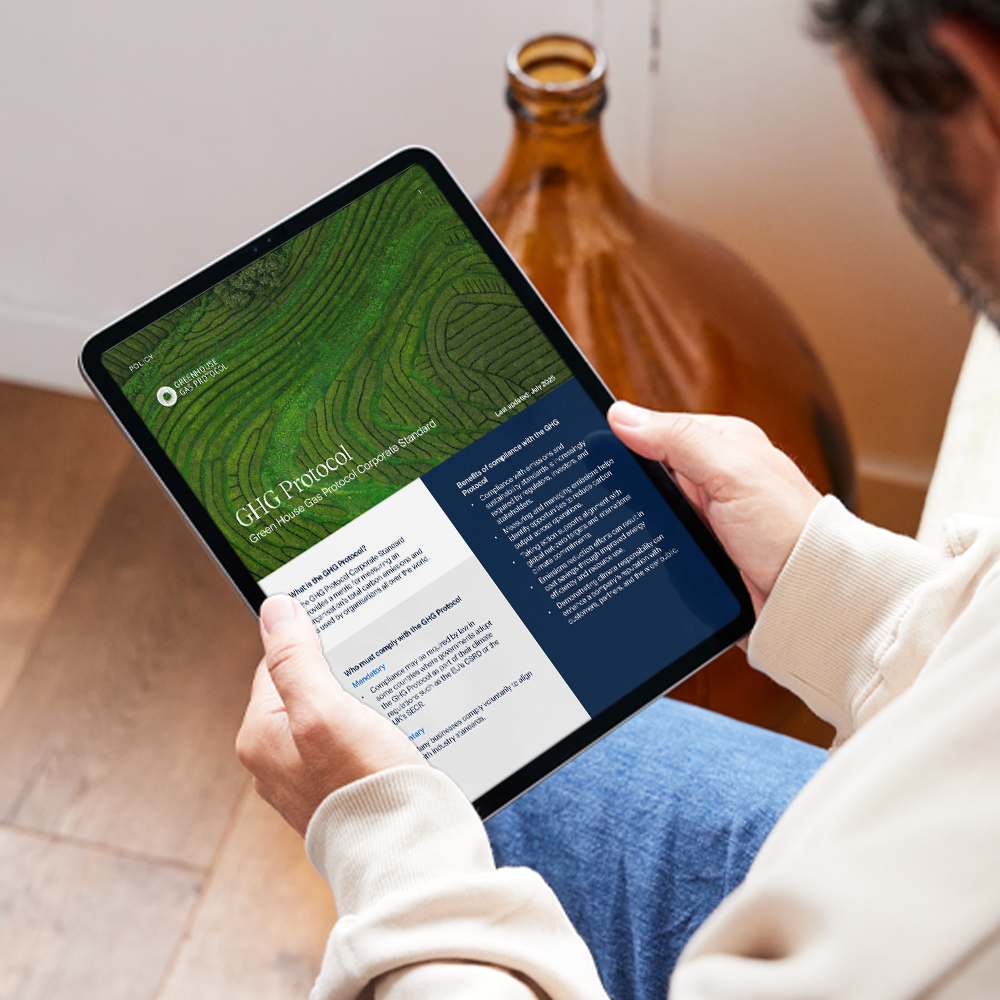POLICY
GHG Protocol Corporate Standard
ENSURE CONSISTENT GHG REPORTING WITH PLANET MARK
The GHG Protocol Corporate Accounting and Reporting Standard (the ‘GHG Protocol Corporate Standard’) is a framework for organisations to measure and report their full carbon footprint. This is known as a greenhouse gas (GHG) emissions inventory.
To develop a compliant GHG emissions inventory, organisations need to account for and report on seven greenhouse gases: carbon dioxide, methane, nitrous oxide, hydroflurocarbons, perfluorocarbons, sulphur hexafluroride, and nitrogren trifluroide.
Keep reading to learn more about the Corporate Standard, and how we can help you align with it.
What is the Corporate Standard?
The Corporate Standard is just one of seven Greenhouse Gas Protocol (GHG Protocol) standards. These set the requirements for collecting, measuring, and reporting on GHG emissions data. The Corporate Standard tailors this guidance to organisations, including businesses, universities, and NGOs.
The goal of the GHG Protocol is to help entities understand their carbon footprint, so that they can take data-backed steps to reduce it. Read our guide to learn more.
Who needs to comply?
Various legislations and voluntary ESG frameworks mandate the use of the GHG Protocol Corporate Standard.
Explore when compliance is a legal or voluntary requirement below, or get in touch to discuss your greenhouse gas accounting and reporting responsibilities in more detail.
Mandatory compliance
Some global climate regulations require or strongly reference the use of the GHG Protocol Corporate Standard. This includes the Corporate Sustainability Reporting Directive (CSRD) and the International Financial Reporting Standards (IFRS) S2.
If you are legally obligated to follow one of these regulations, then you’ll need to align with the standard.
Voluntary compliance
Some climate regulations also recommend, but don’t mandate, the use of the Corporate Standard. This includes the Streamlined Energy and Carbon Reporting (SECR) policy, which requires in-scope organisations to use a trusted GHG reporting method.
You may also need to align with the Corporate Standard if you decide to follow a voluntary ESG framework, like the SBTi’s Corporate Net-Zero Standard. This can help you to set science-based targets for reducing your carbon footprint and achieving net zero.
Understand your sustainability responsibilities
If you’re not sure which climate regulations you need to meet, use our free Carbon Policy Tracker to understand your responsibilities.
How can Planet Mark help?
With our annual membership solution, we give organisations the support, tools, and resources to align with the GHG Protocol Corporate Accounting and Reporting Standard.
The Net Zero Certification Programme guides organisations through four certified milestones to achieving net zero, which includes measuring and reporting on your carbon footprint in line with the Corporate Standard.
When you join the Net Zero Certification Programme, we’ll support you to:
Measure Scopes 1, 2, and 3 emissions across your organisation –> We’ll help you to define your organisational boundaries, identify where you’re generating GHG emissions, and measure your total carbon footprint.
Reduce your total carbon footprint in line with your targets –> We’ll help you to set ambitious, SBTi-aligned targets for reducing your emissions, and implement the decarbonisation solutions needed to achieve them. We’ll also empower you to engage your value chain, so you can ensure that everyone’s working towards the same goals.
Take care of your GHG reporting with confidence –> We’ll support you to report on your emissions in line with the GHG Protocol Corporate Standard, with credible data and a dedicated team of reporting experts.
Measure and reduce your emissions with Planet Mark
We’re here to help you make measurable cuts in line with internationally recognised standards, including the GHG Protocol. Explore our net zero consultancy and certification services to get started.
Insights to help reduce your GHG emissions
What are Scope 3 emissions and why do they matter?
7 Ways Businesses Can Reduce Their Carbon Footprint
The difference between net zero and carbon neutral

Accelerate your sustainability journey
Ready to start your GHG accounting and reporting journey? Get in touch with our experts to find out how we can help you to measure, reduce, and report on your carbon emissions with confidence.




